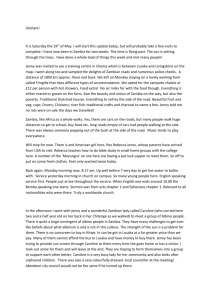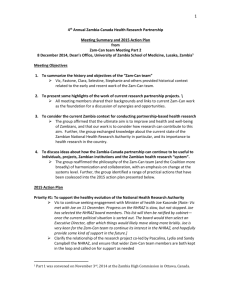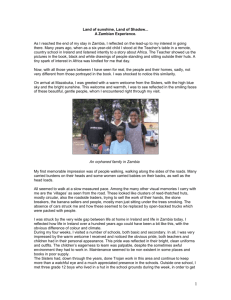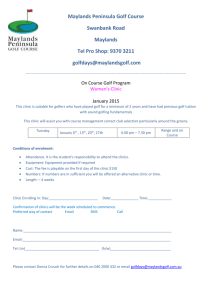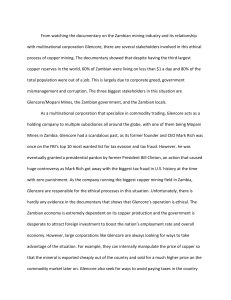Primary Care in the Developing World Dr. Patrick McSharry
advertisement
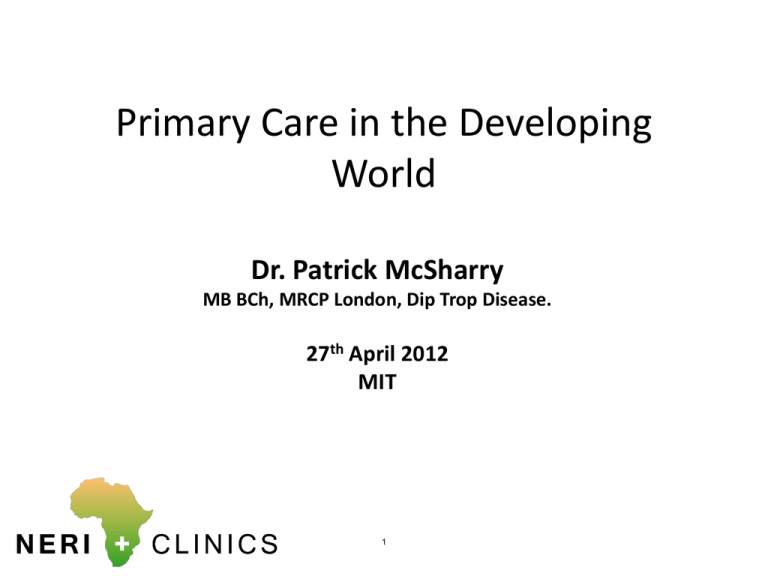
Primary Care in the Developing World Dr. Patrick McSharry MB BCh, MRCP London, Dip Trop Disease. 27th April 2012 MIT 1 Outline • 1. Introduction • 2. Background : Zambia and the developing world. • 3. Primary Healthcare in an impoverished suburban Zambian township a look at Neri Clinic & our work. • 4. Challenges to implementing technology to improve healthcare… a look at a rural population near the border with the DRC. * All Photos or media used are with the consent of the individuals or their guardians 2 Closer look at Indicators of health. • Maternal Mortality • Under 5 Mortality • Life Expectancy 3 Maternal mortality Map showing maternal mortality is highest in countries of Sub-Saharan Africa and South Asia removed due to copyright restrictions. 4 Under 5 mortality Map showing under-5 mortality is highest in countries of Sub-Saharan Africa and South Asia removed due to copyright restrictions. 5 Developing World -Burden of Disease. • 7.6 million children die worldwide every year before their 5th birthday. • The developing world is home to 99% of these deaths with the vast majority (over 60%) in Sub-Saharan Africa. • That is 15 children under the age of 5 dying every minute. Figures from UNICEF 2010 & Lancet 2003 6 That figure: • 15 children under 5 die every minute. What are they dying from? 7 What are the children dying from? Pie chart showing primary causes of death for children under 5 has been removed due to copyright restrictions. Causes include pneumonia (21%), malaria (18%), and diarrhea (16%). 8 UNICEF Zambia • 13 million population • Life expectancy is 46 years Ireland is 80 years • 15% (official figures) of the population are HIV positive • 64% live on less than a dollar a day • Maternal Mortality is 590/100,000 Ireland is 2/100,000 • Under 5 mortality is 110/1000 Ireland is 4/1000 9 Neri Clinics • Established 2008 chance meetings between like minded committed individuals. • Accessible community healthcare staffed by local Zambian professionals. • All in Partnership with local community/NGO/Government. • No administrative costs to our charity in Ireland. • Population of over 30,000 people identified with no healthcare structure. 10 • Clinic opening day- a day for the community. Zambian’s first president Dr. Kaunda launches our clinic. 11 432 consecutive cases… Respiratory Gastro Dermatology Musculoskeletal Gynaecology Urinary tract STI Rheumatological Cardiology Social Neurological Haematological Opthalmic Psychiatry 12 0 50 100 Young man, my age. 13 14 15 16 17 Volunteer Physio at work 18 Zambian Physio at work 19 20 RL a 10 year old with severe spinal disorder kyphoscoliosis. – No specialist orthopaedic opinion. 21 Neri Clinic Service in 2012 • Primary Care day to day run exclusively by Zambian staff with over 15,000 patients • Under 5 clinic • Antenatal Service • Physiotherapy • HIV service (approx 35% positive) • Referral Emergency • Specialist clinics (ENT twice year, Orthopaedics, Dentist, Paediatrics/ Public health specialists.) 22 Neri Clinic Services • Vegetable garden & Educational talks • Nutritional programme. • Sports Teams for soccer & netball. 23 24 25 Neri as a component of the Zambian health service • All of our services are implemented in accordance with the Zambian Ministry of Health or the relevant NGO specifications. – Our statistics are entered into the Zambian national database. – Our workers’ salaries are going to be paid by the Ministry of Health. – Our medications are part funded by the Ministry of Health. 26 Rural Zambia near Serenje • Location – Rural Zambia in the bush 5km from the Democratic Republic of Congo. • 6-7 hours walk to nearest healthcare facility. • Population of subsistence farmers and their families approx 500. • Needs are vast. Closest Government clinics testing 50 febrile patients mainly children for malaria per day 47-49 positives out of those tested. 27 Challenges to the introduction of technology in healthcare 28 The world by night Satellite image showing the earth and night removed due to copyright restrictions. 29 Challenges to the introduction of technology in our clinics • Electricity – None in Serenje (Vaccine cold chain/technology) – Power outages in Lusaka (back up generator) • Computers – Training – Maintenance – Repair 30 Challenges to the introduction of technology in our clinics • Poor Road Network – Inaccessible in rains in Serenje • Staff resistance to change. • Cell phones – No 3G in Lusaka – No coverage of any kind in Serenje 31 Challenges to the introduction of technology in our clinics • Internet – None in Lusaka or Serenje currently – Available in Lusaka – Expensive satellite Internet connectivity is the only option in Serenje. • ($3000 set up and $500 per month for 3GB/month at speeds of 512kbps) 32 eHealth, mHealth & other technology. • Technology has made possible the support, management and communication with the clinic from Ireland to Zambia – Skype – E-mail – Online banking (e.g. staff salaries) • Audit of the service using EMRS 33 eHealth, mHealth & other technology. • Informal specialist opinion currently. • Structured specialist clinics & interventions are in their infancy – Oto-rhino-laryngology surgery – Public health clinics • Use of remote Ultrasound in Antenatal clinic screening 34 Potential Initiatives • Specialist care to the most remote areas can only be achieved with eHealth/ mHealth. • We currently have informal limited access to: – – – – – – ENT surgeon Cardiothoracic Dentistry Pulmonologist Paediatrician Orthopaedic 35 Potential Initiatives – Coordinated registry of specialist referral options for patients who need it in the most remote areas – We would like for a child in rural Zambia to have access to the best medical opinions in the world if needed • Achievable with information technology/ eHealth There isn’t a shortage of the specialists willing to give their expertise for free. 36 37 MIT OpenCourseWare http://ocw.mit.edu HST.S14 Health Information Systems to Improve Quality of Care in Resource-Poor Settings Spring 2012 For information about citing these materials or our Terms of Use, visit: http://ocw.mit.edu/terms.

